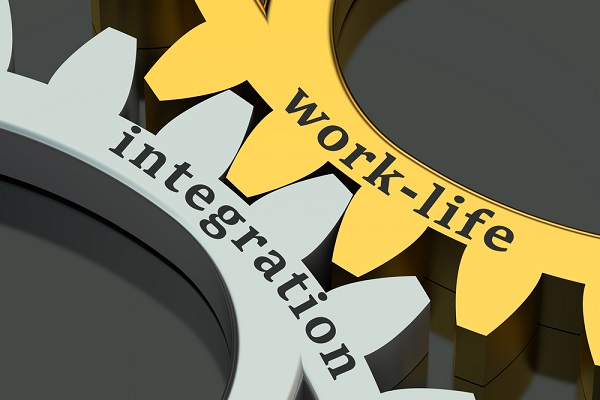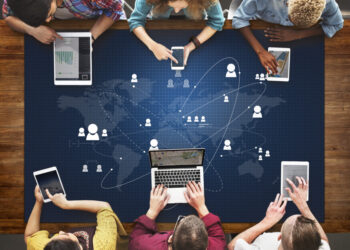For decades, the dominant philosophy of professional life was one of separation: a rigid demarcation between our careers and our personal lives, a concept we called “work-life balance.” It was a model that assumed our professional and personal identities were two distinct entities, constantly in conflict and in need of a delicate equilibrium. But in an era of ubiquitous technology, where our phones connect us to the office 24/7, that premise is a relic of the past. Today, a new and more humane philosophy is emerging, one that rejects the idea of a zero-sum game between our work and our lives. This is the era of work-life integration, a movement that recognizes our professional and personal identities are not separate but are a seamless, interconnected whole.
This isn’t about working all the time. It is a profound shift in mindset that uses technology not as a chain but as a tool for liberation, allowing us to weave our work into the rich tapestry of our lives with greater flexibility and purpose. This article is a deep dive into this transformative era, exploring the core pillars that define tomorrow’s professional landscape, the groundbreaking strategies that are making it a reality, and the critical challenges we must navigate to build a more flexible, humane, and sustainable future for work.
The Grand Shift

To understand the power of work-life integration, we must first appreciate the flaws of the “balance” model it is replacing. The move from separation to a seamless blend is a direct response to the demands of our digital age.
- The Flawed Premise of “Balance”: The concept of work-life balance was a noble one, but it was built on a flawed premise. It assumed that work and life were two separate entities that could be neatly compartmentalized. This model, which was a product of the industrial era, with its rigid work schedules and its physical separation of home and office, is no longer a viable one in an age of ubiquitous technology.
- The Digital Age and Its Demands: The proliferation of smartphones, laptops, and the internet has fundamentally blurred the lines between our work and our personal lives. We can now check our emails from a coffee shop, take a video call from a park, and respond to a message from a colleague at night. The idea of a strict separation between work and life is now a practical impossibility.
- The Post-Pandemic Catalyst: The global pandemic accelerated this shift in a profound way. The forced experiment in remote work demonstrated that, for many knowledge-based industries, productivity did not suffer and, in some cases, even improved. This proof of concept shattered long-held assumptions about the necessity of the physical office, paving the way for a more permanent, long-term shift to a new, more flexible model of work.
The Defining Pillars of Work-Life Integration
The future of work is not a monolith; it is a tapestry of new and innovative approaches that are being woven together to create a more dynamic and flexible professional landscape.
A. Flexibility and Autonomy: The Power of Choice
At its core, work-life integration is about providing employees with a high degree of flexibility and autonomy. This is a movement that believes that employees, when given the power to choose how, when, and where they work, will be more productive, more engaged, and more loyal.
- Flexible Schedules: This is an approach that moves away from a rigid 9-to-5 schedule to a more flexible one, with a focus on results, not on “face time.” An employee might start their day later and work later at night, or they might take a break in the middle of the day to attend a child’s school event.
- Location Independence: This is an approach that believes that work can be done from anywhere in the world, with a focus on providing employees with a high degree of location independence. This is a powerful expression of the new era of work, with professionals able to work from anywhere in the world with a reliable internet connection.
B. Purpose-Driven Work: A New Source of Fulfillment
In the old model of work, a job was often seen as a means to an end, a way to earn a living. In the new model, work is seen as a source of purpose and fulfillment. Work-life integration is a movement that believes that our professional and personal lives can be a seamless blend of purpose, with a focus on finding a career that is a direct reflection of our passions and our values. This is a powerful antidote to digital burnout and a key driver of employee engagement and well-being.
C. A Focus on Employee Wellness: Beyond a Perk to a Necessity
In the new era of work, employee wellness has moved from a perk to a necessity. Companies are realizing that the well-being of their employees is not just a nice-to-have but a core component of their success.
- Mental Health Support: This is a new focus on mental health, with companies providing access to mental health apps, encouraging digital detoxes, and fostering a culture that prioritizes a healthy and sustainable work-life balance.
- Physical Wellness: This is a new focus on physical wellness, with companies providing employees with a stipend for a gym membership or a yoga class, and a focus on encouraging employees to take a break and to get a move on.
- The Role of a “Chief Well-being Officer”: As employee wellness becomes a core component of a company’s success, a new C-suite position is emerging: the Chief Well-being Officer. This individual is responsible for a company’s wellness strategy, with a focus on everything from a mental health policy to a physical wellness program.
D. The Role of Technology as an Enabler: The Digital Toolkit
Technology is often seen as the source of our digital stress. But in a model of work-life integration, it is a powerful enabler. A company that embraces this philosophy provides its employees with a new generation of innovative technologies that are designed to make work more flexible, more collaborative, and more efficient. This is a movement that believes that technology can be a tool for liberation, not a chain, a tool that can be used to weave our work into the rich tapestry of our lives.
The Strategies of Integration in Action
The future of work is not a fixed destination; it is a continuous evolution. Here are a few strategies that are being used to make a more flexible and humane workplace a reality.
- The Hybrid-First and Asynchronous Models: This is a powerful blend of in-person and remote work. The hybrid work model is a new standard, with a focus on using time in the office for in-person collaboration and a focus on using time at home for deep, focused work. The asynchronous work model, which is particularly powerful for global teams, eliminates the need for a rigid schedule and provides employees with the flexibility to work when they are most focused and productive.
- The 4-Day Work Week: This is a bold experiment in productivity and wellness. It is a model that believes that employees can achieve the same amount of work in four days that they can in five. This is a powerful way to improve employee well-being, to increase productivity, and to reduce a company’s carbon footprint. It is a movement that is gaining momentum around the world, and it is a powerful expression of the new era of work.
- The Digital Nomad and Global Workforce: The digital nomad lifestyle has moved from a niche to a mainstream trend. This is a powerful expression of the new era of remote work, with professionals able to work from anywhere in the world with a reliable internet connection. This is a movement that is fundamentally changing our relationship with both work and travel, blurring the lines between the two in a powerful and inspiring way.
- Conscious Boundaries: The Art of Disconnecting to Reconnect: In a model of work-life integration, the art of disconnecting is a revolutionary act. It is the practice of creating clear boundaries between our physical and digital lives. This is a mindset that says that we will not check our emails at the dinner table or on a Sunday morning. It is a commitment to being present in the moment and to connecting with the people we love. This is a powerful antidote to digital burnout and a key driver of employee well-being.
The Challenges and Ethical Imperatives of Integration

While the future of work is exciting, it is not without its challenges. Navigating these hurdles is key to building a future that is flexible, humane, and sustainable.
- The Risk of Burnout and “Always On” Culture: The blurring of the lines between work and life has created a new risk of burnout and overwork. In a remote environment, it can be difficult for employees to “turn off” at the end of the day. Companies must be intentional about fostering a culture that prioritizes a healthy and sustainable work-life balance, with a focus on encouraging employees to disconnect and to take a break.
- The Challenge of Company Culture in a Decentralized World: In a decentralized workforce, a physical office is no longer the central hub. The new central hub is a workplace management platform, a digital headquarters that provides employees with access to everything they need, from a company directory to a project management dashboard. But building and maintaining a strong company culture in a decentralized world is a significant challenge. It requires a new focus on virtual team-building events, online social clubs, and a company-wide commitment to fostering a sense of community and connection.
- The Digital Divide and Inclusivity: The remote work revolution has created a new digital divide. Not every employee has access to a reliable internet connection or a comfortable home office. Companies must be intentional about ensuring that every employee has the tools and the support they need to succeed in a remote environment, with a focus on providing a stipend for a home office, a reliable internet connection, and access to a co-working space.
- The Responsibility of Leadership: The move to a model of work-life integration requires a new kind of leadership. Leaders must move away from a focus on “face time” to a focus on results. They must be able to trust their employees to get the work done, and they must be intentional about fostering a culture of autonomy, flexibility, and a sense of purpose.
A Look Ahead
The future of work is not a fixed destination; it is a continuous evolution. Here is a look ahead at what we can expect from the next generation of work.
- AI and Automation for a More Humane Workplace: Artificial intelligence is playing an increasingly important role in the remote workplace. AI-powered tools can automate tedious, repetitive tasks, such as scheduling meetings, responding to emails, and managing project deadlines. This frees up employees to focus on more creative and strategic work, making them more productive and more engaged.
- The Redefinition of the Office: The physical office will not disappear, but it will evolve. It will become a cultural hub, a place for in-person collaboration, and a space for social connection. It will be a place that is designed to support the new era of remote work, with a focus on flexibility, a variety of meeting spaces, and a new kind of work-life integration.
- The Rise of the “Chief Well-being Officer”: As employee wellness becomes a core component of a company’s success, a new C-suite position is emerging: the Chief Well-being Officer. This individual is responsible for a company’s wellness strategy, with a focus on everything from a mental health policy to a physical wellness program.
Conclusion
The remote work revolution is not just a change in location; it is a fundamental shift in our relationship with work. It is a movement that has been driven by a demand for greater flexibility, autonomy, and a healthier work-life balance. The principles of work-life integration we have explored in this guide are not just a collection of new ideas; they are a blueprint for a more humane, more sustainable, and more purpose-driven future for work.
This guide has only begun to explore the vast and exciting possibilities. We have seen how a blend of a hybrid work model, asynchronous work, and a new generation of virtual collaboration tools is creating a new language of work. This transformation is not without its challenges; it requires a new skill set and a new way of thinking. But the opportunity is even greater. The ultimate reward for this shift in our work philosophy is not just a reduction in our carbon footprint. It is the creation of a professional landscape that is more resilient, more in tune with the rhythms of our daily lives, and more conducive to a life that is both meaningful and profoundly human. The future of work is not about a return to the past; it is about a bold leap forward into a future that is defined by a new kind of freedom and a new kind of humanity.




